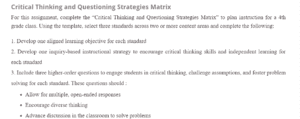Critical Thinking and Questioning Strategies Matrix
Grade Level: 4th Grade
Content Areas (Minimum of two): English Language Arts, Mathematics
| Standards | Aligned Learning Objectives | Inquiry Based Instructional Strategies | Higher Order Question #1 | Higher Order Question #2 | Higher Order Question #3 | Assessment |
| Selected Standard #1: CCSS.ELA-LITERACY.RL.4.9
Compare similar themes and topics in stories, literature, and myths from different cultures. |
Students will identify themes in a story. |
Read the passage with students in class. Ask questions that guide them to identify themes in the story. |
What examples of themes can you find in the story? |
How have these themes been demonstrated? |
How are these themes similar to real-life experiences? |
Students will identify themes in a class discussion. |
| Selected Standard #2: CCSS.MATH.CONTENT.3.NF.A.3.A
Understand fractions as equivalent when they are at the same point on the number line or the same size |
Students will match equivalent fractions. |
Engage students in a class discussion where they identify equivalent fractions together. |
What fractions do you think are similar in the list provided? |
Why do you think they are similar? |
How can one fraction be reduced to be identical to its equivalents? |
Students will answer a few questions where they identify equivalent fractions. |
| Selected Standard #3: CCSS.MATH.CONTENT.K.G.A.2
Accurately name shapes regardless of their size and orientation. |
Students will identify and create shapes in different sizes and orientations |
Students will engage in a class project where they make 2D shapes using pieces of paper |
What are some examples of common shapes that you know? |
What are some examples of objects you know that are in these shapes? |
Can you create shapes from paper? |
Students will create 2D shapes with paper and scissors |
Rationale:
It is important to teach students to learn higher-order thinking. This kind of thinking encourages them to learn beyond the memorization level. Higher-order thinking requires higher cognitive processing. It is also learning that sticks longer than memorizing information. The matrix above summarizes some of the strategies that I would use as a teacher to encourage fourth-grade students to perform higher-order thinking. The matrix includes learning for three objectives in English Language Arts and Mathematics.
For each of the objectives, inquiry-based instructional strategies have been used. This is a form of instruction that prioritizes the students’ questions. These instructional strategies encourage critical thinking and student creativity to reach a conclusion (Miri, David, & Uri, 2007). The instructional strategy that is used in the first objective is to ask students questions about a passage they read to help them identify themes. In the process of asking questions, the students will be encouraged to think and find answers. This is better than identifying the themes on their behalf. For the second objective, the instructional process will involve engaging students in a class discussion where they identify similar fractions together. This strategy also encourages their inquiry of the components that make equivalent fractions. In the third objective, the students will engage in a project where they create shapes. To create the shapes, they must first make sure that they understand the elements of different shapes.
These lessons also include different questions that have been created to encourage critical thinking. The higher-order questions have been based on Bloom’s taxonomy for teaching students. This taxonomy categorizes questions into categories of knowledge, comprehension, application, analysis, synthesis, and evaluation (Adams, 2015). For instance, the question, “What examples of themes can you identify in the story?” examines the students’ comprehension of the story. Similar questions have been used in all objectives to encourage thinking.
References
Adams, N. E. (2015). Bloom’s Taxonomy Of Cognitive Learning Objectives. Journal of the Medical Library Association: JMLA, 103(3), 152.
Miri, B., David, B. C., & Uri, Z. (2007). Purposely Teaching For The Promotion Of Higher-Order Thinking Skills: A Case Of Critical Thinking. Research in science education, 37(4), 353-369.
ORDER A PLAGIARISM-FREE PAPER HERE
We’ll write everything from scratch
Question
Critical Thinking and Questioning Strategies Matrix
For this assignment, complete the “Critical Thinking and Questioning Strategies Matrix” to plan instruction for a 4th grade class. Using the template, select three standards across two or more content areas and complete the following:

Critical Thinking and Questioning Strategies Matrix
- Develop one aligned learning objective for each standard
- Develop one inquiry-based instructional strategy to encourage critical thinking skills and independent learning for each standard
- Include three higher-order questions to engage students in critical thinking, challenge assumptions, and foster problem solving for each standard. These questions should :
- Allow for multiple, open-ended responses
- Encourage diverse thinking
- Advance discussion in the classroom to solve problems
- Promote problem solving of real-world experiences
- Create one assessment for each standard that aligns with the standard and learning objective
Support your plan with 2-3 scholarly resources.
While APA format is not required for the body of this assignment, solid academic writing is expected, and in-text citations and references should be presented using APA documentation guidelines, which can be found in the APA Style Guide, located in the Student Success Center.
Critical Thinking and Questioning Strategies Matrix
Grade Level: 4th Grade
Content Areas (Minimum of two):
| Standards | Aligned Learning Objectives | Inquiry Based Instructional Strategies | Higher Order Question #1 | Higher Order Question #2 | Higher Order Question #3 | Assessment |
| Selected Standard #1: | ||||||
| Selected Standard #2: | ||||||
| Selected Standard #3: |
Rationale:

